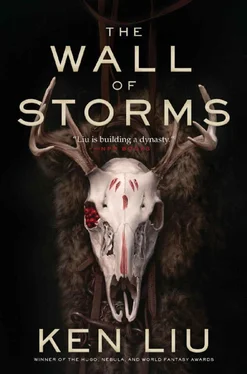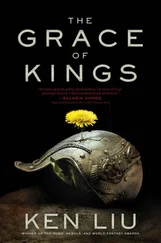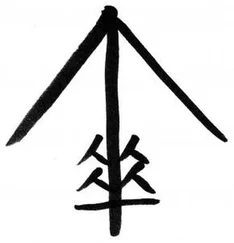“No,” said Théra. “It’s already closing! Zomi was right.”
Indeed, the cyclones that made up the Wall of Storms were already reversing their course. The mountains of cloud and water on either side of the passage were closing in with the Lyucu ships still trapped between them.
PAN: A MONTH EARLIER.
Zomi Kidosu was very busy. Not only was she in charge of preparing for the princess’s voyage to Ukyu and Gondé, but she also had to evaluate many proposals for new machinery and new policies that Empress Jia declared were within the bailiwick of the Imperial Farsight Secretary.
In truth, Zomi understood that some of these duties were traditionally within the purview of the prime minister. However, Empress Jia preferred to distribute the duties between her and Cogo Yelu. It was either a way to punish Cogo for the way he had zealously prosecuted Otho Krin after the unveiling of the empress’s plot or a way to ensure that Cogo Yelu didn’t grow complacent without someone to challenge his opinions.
“I trust systems,” the empress had said to Zomi, “not individuals. You’re skilled at engineering machinery; I want to see if you’re as skilled at engineering the system of governance. Perhaps we will give your proposals regarding the examination system a try.”
Zomi sighed. The exercise of power was a heavy responsibility. She had to learn to make a home for herself in this new role, to balance her impulses for radical changes with the wisdom of cautious gradualism. On top of it all, Théra had also asked her to remain vigilant and to assist in the shift of power from Théra’s mother to her brother over time.
“Both of them will need and want your loyalty,” said Théra. “You’ll have to be careful.”
“You know I’m no good at politics,” said Zomi. “Never had any talent for it.”
“Let your conscience be your guide,” said Théra. “And trust in your love of the common people—they always come first. On that point, at least, everyone in the House of Dandelion is in agreement.”
As the day for Théra’s departure approached, Zomi tried to spend as much time with Théra as she could. Yet something about Théra’s quoting of Luan Zyaji’s poem gnawed at her. She returned to the poem and read it again.
Weigh the fish, the universe is knowable.
A cruben breaches; the remora detaches.
Mewling child, cooing parent,
Grand-souled companions, brothers,
Wakeful weakness,
Empathy that encompasses the world.
To imagine new machines, to see unknown lands,
To believe the grace of kings belongs to all.
Grateful.
She stared at the poem, nonplussed. She had not paid enough attention to the form of the poem at the time she first read it due to the freshness of her grief, but now, in a calmer frame of mind, the strangeness of the poem struck her.
Her teacher had a genuine love for Classical Ano forms and was an accomplished writer and poet in that ancient language. But this poem followed no Classical Ano form that she knew of. The ancient Ano prized visual symmetry, and poems composed in Classical Ano always followed fixed patterns dictating the number of logograms per line. The poems were meant to be recited aloud as well as silently admired as visual compositions.
But each line of this poem had a different number of logograms: seven, six, four, three, two, five, zero (the blank line), eight, nine, one. Why would her teacher be so careless?
True, her teacher had written this on his deathbed, and it was possible that he had lost the ability to compose with care for visual appeal. But Zomi knew instinctively that couldn’t be the real explanation.
The poem has ten lines, each line being a different numeral.
Her teacher had always instructed her on the importance of engineering as the art of assembling existing machinery to achieve a new purpose. Was he using the form of the poem to send her a message, a different message than the words of the poem indicated?
Zomi went back to the calculations in Gitré Üthu concerning the opening of passages in the Wall of Storms. There were too many skipped steps in his derivations for her to be able to reconstruct his work fully, but all the steps that she could follow made sense.
Her eyes were drawn to a doodle in the margin of one of the pages: rows of dots arranged in numerical order—blank space, one, two, three, four…
And she finally understood what her teacher had intended with the poem: It was a code. The number of logograms in each line indicated the “real number” while the position of the line in the poem was the cipher. Thus, zero mapped to seven, one mapped to six, two mapped to four, and so on.
Luan Zyaji had done what he could to obscure his method of calculation and presented false results to the Lyucu. But he had also left a key to Zomi for deciphering the false results to get at the real numbers. At the time of his death, however, he couldn’t be sure that whatever information he gave to Zomi wouldn’t fall into the hands of the Lyucu, and so he had embedded the key in the poem.
IN THE SEA NORTH OF DASU: THE FIFTH MONTH IN THE FIRST YEAR OF THE REIGN OF SEASON OF STORMS.
As Théra and Takval watched, the Wall of Storms closed in on the city-ships.
The cipher text in Gitré Üthu had predicted a false opening; the real opening, according to Zomi, wouldn’t happen for another ten years. It was a testament to his skill that even the false calculations pointed to a temporary opening in the Wall, completing a trap that must have taken him days to work out.
Théra imagined the terror the thousands aboard those ships must be feeling as towering mountains of water and clouds loomed over them, bolts of lightning flashing within—hopeless, numbing terror, knowing that there was no escape, that death was just seconds away. In a single moment, nature would kill more people than had died at the Battle of Zathin Gulf. Pity overwhelmed her heart, and she turned her face away.
Luan Zyaji would have his vengeance after death.
Pékyu Vadyu’s forces on Rui and Dasu would still be a threat to Dara, but without Cudyu’s reinforcements, there was a much better chance that Phyro and Jia would be able to deal with them.
She shook her head; she had to change the subject of her thoughts.
“I’m sorry,” said Théra to Takval. “Looks like Zomi was right. There will be no path through the Wall of Storms today.”
Takval was distraught. “But we can’t afford to wait! In ten more years, who knows how many more of my people will die in winter storms and summer droughts?”
“We may not have to wait that long,” said a smiling Théra. “Zomi gave us another way just in case this passage didn’t work out.”
As if in response, the sea around them roiled and exploded. Ten crubens, the majestic sovereigns of the sea, surfaced and bobbed next to the ships, dwarfing the vessels with their bulk.
Théra laughed. “Looks like the old friends of the House of Dandelion have decided to help us again.”
The ability of Dissolver of Sorrows and her sister ships to dive beneath the sea wasn’t just a means of concealment; it was a way to bypass the Wall of Storms.
Inspired by the way Prince Takval himself had come to Dara, Zomi had come up with a bold new idea. Since whales were clearly able to swim under the Wall of Storms safely, then it made sense that underwater boats could as well. Although the mechanical crubens were limited to sailing along underwater volcano ranges, a ship that could sail underwater could also take a page from the whalers and be propelled by cetaceans.
Читать дальше













